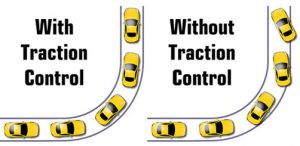What Does Traction Control Do?
Traction control is a driving safety system that is integrated into most modern cars. The traction control system (TCS) also known as Anti Slip Regulation (ASR), depending on the vehicle may be a standalone system, though more frequently in modern cars it’s an integrated function of the vehicle’s Electronic Stability Control (ESC).
The purpose of traction control is to restore traction between the tyres and the road surface when traction has been lost. Traction control does not increase traction, but rather helps to reduce loss.
Traction control essentially uses the same components as the anti-lock braking system (ABS). During acceleration, sensors compare rotational speeds of all vehicle wheels and if wheel-slip or wheel spin occurs on any of the drive wheels, the traction control system initiates a signal to brake the affected wheel/s.
Some versions of traction control also reduce engine power to the affected drive wheels. When the system is actively engaged, a slight pulsing of the accelerator pedal may be felt.

Common benefits of traction control are for example, pulling out of a busy junction on a wet slippery road. Without traction control, the vehicle’s tyres may spin and the vehicle would make slow progress. With the system engaged, the tyres would keep traction and move from the junction quickly.
Traction control is also beneficial when cornering in a vehicle. If the driver applies too much throttle on a corner, the vehicle may understeer (front wheel drive vehicles) or oversteer (rear wheel drive vehicles). Traction control will detect wheel-slip much faster than the driver and aid the driver in maintaining control.
